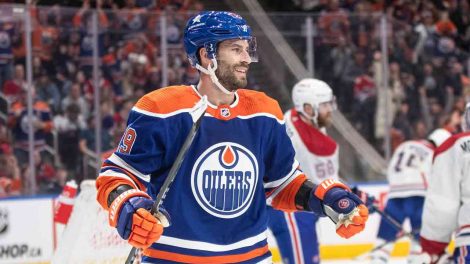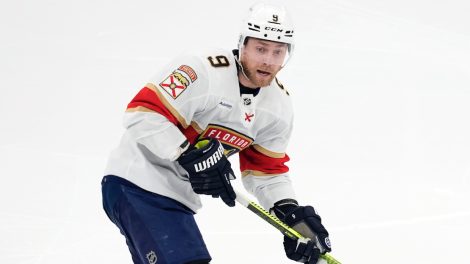You always have to be careful when analyzing early-season sample: with the whim of a bouncing puck, short-term trends can be flipped on their heads quickly in the NHL, making it difficult to determine what’s short-term noise and what is a lasting trend.
But that doesn’t mean there aren’t useful nuggets of information for us to glean from what’s transpired so far in late October. One practical benefit of paying attention to what’s going on is that we can gain insight into how teams want to play, specifically with regards to the deployment of their players and how ice time is divided.
This rings especially true for teams that underwent fundamental changes in the off-season, whether it be with their on-ice personnel or the staff behind the bench. In the case of the Vancouver Canucks, it’s a little of both, with arguably no team being more active than they were during this summer’s free agency period.
[snippet id=3317857]
But for our purposes perhaps even more interesting than the influx of player talent, is the person who’s been tasked with figuring out the optimal way to make all of those new pieces fit into the lineup. Travis Green was brought in for his first NHL head coaching job, so he doesn’t have a track record at this level for us to point to as evidence for how he’d operate.
Green hasn’t waited long to make his first noteworthy impression on the lineup, cutting right to the core of things with his handling of Henrik and Daniel Sedin. If you were only following websites that list depth charts or the team’s own social media accounts you wouldn’t know it, but there’s been a seismic change in the deployment of the team’s forward group from years past.
After more than a decade of listing whichever trio featured the twins as the Canucks’ de facto top line, the first couple weeks of Green’s regime have represented a changing of the guard in Vancouver:
| Season | Henrik Sedin 5v5 TOI/Game | Canucks Forward Rank | Daniel Sedin 5v5 TOI/Game | Canucks Forward Rank |
|---|---|---|---|---|
| 2007-2008 | 13.14 | 1st | 12.97 | 2nd |
| 2008-2009 | 13.54 | 1st | 13.27 | 2nd |
| 2009-2010 | 14.18 | 1st | 13.98 | 2nd |
| 2010-2011 | 14.56 | 1st | 13.97 | 2nd |
| 2011-2012 | 14.15 | 2nd | 14.19 | 1st |
| 2012-2013 | 14.60 | 1st | 14.34 | 2nd |
| 2013-2014 | 14.84 | 2nd | 14.81 | 3rd |
| 2014-2015 | 13.51 | 1st | 13.40 | 2nd |
| 2015-2016 | 13.51 | 1st | 13.51 | 2nd |
| 2016-2017 | 15.02 | 1st | 14.51 | 2nd |
| 2017-2018 | 10.07 | 10th | 9.72 | 11th |
(all data via Corsica)
Since wrangling the keys to the franchise from Markus Naslund and The West Coast Express somewhere around 2006, there’s only been one time those following 10 seasons in which Henrik and Daniel weren’t number one and two in usage amongst Canucks forwards: 2013-14, when Ryan Kesler narrowly edged them out.
Ironically enough, that was the season in which they actually played the most they ever have overall, with John Tortorella famously riding his top players into the ground during his brief stint with the team.
It’s no accident that Vancouver’s tailspin as a franchise mirrors the one the Sedins have taken themselves, with the performance of both twins progressively eroding year over year since team and player(s) alike were at their peaks in 2011.
Age-related decline can be pretty ruthless – as the clicks on the odometer pile up, things tend to go south awfully quickly when a player loses it.
The Sedins fought this off admirably well into their 30s because their guile and craftiness lended itself to a sneakily successful old man’s game, but they too were inevitably succumbing to father time.
That’s what makes the early returns this season all the more encouraging. While the stupendously high level of play the Sedins used to have is long gone now, it does appear that Green and his staff have stumbled upon a formula that puts them in a better position to succeed, which will extend their longevity as useful contributors.
As the saying goes, sometimes less is more. That certainly appears to be the case here, with the Sedins adapting to being sheltered from the heavy exposure to which they’ve become accustomed.
This reduced role may be an unfamiliar one, but they’re better suited for it these days. The Sedins produce offence more efficiently on a per-minute basis now than they have in some time.
| Season | Henrik 5v5 Points/Hour | Daniel 5v5 Points/Hour |
|---|---|---|
| 2007-2008 | 2.12 | 1.97 |
| 2008-2009 | 2.79 | 2.73 |
| 2009-2010 | 3.66 | 3.75 |
| 2010-2011 | 2.66 | 2.99 |
| 2011-2012 | 2.48 | 2.17 |
| 2012-2013 | 2.23 | 2.14 |
| 2013-2014 | 1.85 | 1.61 |
| 2014-2015 | 1.79 | 1.86 |
| 2015-2016 | 1.74 | 1.79 |
| 2016-2017 | 1.51 | 1.41 |
| 2017-2018 | 2.24 | 2.32 |
(Note: We’re focusing only on 5-on-5 data here, which is good because the Canucks’ power play has been a downright abomination this season, and could very well warrant an entire deep dive of its own)
Reminiscent of the Alain Vigneault days, they’re being fed a healthy dose of offensive zone starts and making the most of the favourable deployment. With the two of them – and their rotating third wheel du jour, most recently Jake Virtanen – on the ice at five-on-five the Canucks have been tilting the ice on their opponents. This is particularly true on the offensive end, where the Sedins are back to generating shots and goals at rates resembling their heyday.
If they can start relying on the goaltender to make some saves behind them, they figure to once again bounce back to the positive side of the on-ice goals-scored differential, a territory they’d reliably resided in for many years prior to the onset of their decline (which culminated in a truly miserable 2016-17 campaign).
| Season | Shots For/Hour | Shots For % | Goals For/Hour | Goals For % | Expected Goals For/Hour | Expected Goals For % | PDO |
|---|---|---|---|---|---|---|---|
| 2007-2008 | 46.85 | 52.61 | 2.44 | 52.02 | 2.23 | 56.36 | 99.6 |
| 2008-2009 | 51.86 | 54.11 | 2.99 | 63.44 | 2.46 | 52.81 | 103.6 |
| 2009-2010 | 55.42 | 55.88 | 4.21 | 63.77 | 2.75 | 56.00 | 105.1 |
| 2010-2011 | 52.90 | 55.03 | 3.13 | 60.26 | 2.49 | 53.34 | 102.5 |
| 2011-2012 | 54.87 | 56.36 | 2.99 | 60.86 | 2.42 | 51.43 | 102.7 |
| 2012-2013 | 53.41 | 59.84 | 2.91 | 68.63 | 2.55 | 61.79 | 104.5 |
| 2013-2014 | 51.83 | 54.52 | 2.42 | 59.61 | 2.27 | 54.50 | 101.7 |
| 2014-2015 | 49.70 | 54.28 | 2.20 | 53.07 | 2.01 | 49.20 | 98.9 |
| 2015-2016 | 44.28 | 48.37 | 2.06 | 53.85 | 2.01 | 47.81 | 101.9 |
| 2016-2017 | 42.22 | 47.73 | 1.90 | 42.53 | 1.67 | 42.30 | 98.8 |
| 2017-2018 | 52.80 | 58.28 | 2.75 | 46.53 | 2.73 | 66.01 | 87.7 |
Ultimately, the rearranging of deck chairs here doesn’t really change the outlook for the Canucks in 2017-18. Even with a more productive version of the Sedins, they look destined for a third consecutive season of losing more than they’re winning and holding out hope that it results in the ping pong balls finally bouncing their way.
But that doesn’t diminish the importance of this lineup development for the team and its fans. It’s a change that should be embraced with open arms, as it represents a necessary preliminary step in the rebuild that people in Vancouver have been clamouring for. Even if it seems like an obvious one, it’s still a change the Canucks have been reluctant to put into effect, which makes it notable that it’s finally happening.
The optimistic reading of what it means for this franchise is that thefuture is a focus for Vancouver, as any delusion of a quick fix “retooling” has faded out of the vernacular. With the Sedins starting to be phased out of the plans as they take on more of a supporting role, it leaves more ice time and opportunity for the various younger pieces already in place. These players can now showcase what they’re capable of as the organization uses 2017-18 to figure out who will still be around by the time the Canucks are ready to compete again in a few years.
And if the twins are capable of turning back the clock and cobbling together one final throwback season while sprinkling in some acts of offensive wizardry along the way too, well then that’s just gravy.
[relatedlinks]








